India and Bangladesh might be two different countries, but they share a lot in common. Apart from the cultural, historical, and linguistic linkages between the two neighbors, one thing which they mutually share is one of the most beautiful natural ecosystems.
Probably that is the reason it is named ‘Sundarbans’ – meaning ‘beautiful forest’.
The Sundarbans is a vast mangrove forest located in the Gangetic delta region of the Bay of Bengal, between India and Bangladesh. This forest provides a natural infrastructure and protection to nearby highly populated areas of the two countries by preventing erosion and absorbing climatic impacts during extreme weather events such as hurricanes.
The forest is also a biodiversity hotspot with hundreds of species of trees and plants growing within the swampland including some of the endangered ones. The most famous species among them is the Royal Bengal tiger, the national animal of both India and Bangladesh.
Not only Sunderbans, but mangroves across the world are also important and unique ecosystems found in coastal areas.
Mangroves are a group of trees and shrubs that grow in the intertidal zones of tropical and subtropical coastlines. They are uniquely adapted to survive in harsh environments with high levels of saltwater, flooding, and tidal fluctuations. The marshy forests also help stabilize the region’s coastline ecosystem and prevent erosion.
Let us look at some of the key reasons that make mangroves important:
Protect coastlines
The intricate and sturdy root systems of mangrove trees help form a natural barrier against violent storm surges and help to protect coastlines. The dense roots also help in binding soils which prevents soil erosion.
That is not all, the root system slows down water flows that help to stabilize shorelines and prevent sediment from washing into the sea. The complex root systems filter nitrates, phosphates, and other pollutants from the water, improving the water quality flowing from rivers and streams into the estuarine and ocean environment.
In an experiment conducted using a model, the importance of mangroves in protecting coastlines is clearly visible.
Support biodiversity
Mangrove forests provide a habitat for a highly diverse range of plants and terrestrial species.
A huge variety of wildlife lives or breeds in the mangrove ecosystem – the shade of trees provides ground for terrestrial animals while branches of the mangroves act as bird rookeries and nesting areas. In addition, the root system provides a conducive place for the breeding of many marine species, including fish, shrimp, crabs, and other shellfish.
Carbon storage
Mangrove forests are highly effective at storing carbon, both in the trees themselves and in the sediment below. This makes them an important tool in mitigating climate change.
Research done on coastal mangroves found that mangrove forests can store up to four times more carbon than other tropical rainforests.
Sustain local communities
Mangroves provide a range of resources that support local communities, including wood, plant products, and food. Plant extracts are collected by locals for their medicinal qualities and the leaves of mangrove trees are often used for animal fodder.
Marine organisms like fish and crustaceans also provide food and employment to the local people.
Promotes Tourism
The unique landscape of mangrove forests provides good tourist experiences and recreation. The forests provide a conducive environment for activities like sports fishing, kayaking, and birdwatching tours.
However, it is important that authorities and tourists maintain and ensure that they don’t disturb the forests’ delicate ecosystem.
Watch the video to get a visual perspective on the importance of mangroves.
To create awareness of the importance of mangroves, International Day for the Conservation of the Mangrove Ecosystem is observed every year on July 26.






Add comment